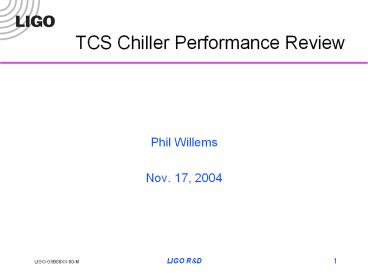TCS Chiller Performance Review
Title:
TCS Chiller Performance Review
Description:
Site chilled water and TCS table water pipes interlaid and touching ... After noise test, chiller was switched on ... Much damage and corrosion to the chiller ... –
Number of Views:320
Avg rating:3.0/5.0
Title: TCS Chiller Performance Review
1
TCS Chiller Performance Review
- Phil Willems
- Nov. 17, 2004
2
Design Requirements
- Laser temperature around room temperature, .5K
- Flow rates
Device Max power dissipated Flow requirement Source of requirement
Carbon dioxide laser 80W ½ gpm Access Laser Co.
Laser power supply 40W cool to the touch Access Laser Co.
AOM 30W 250 ml/min IntraAction, Inc.
AOM driver TBD TBD IntraAction, Inc.
- Noise acoustic and EMI must be under ambient at
nearest sensitive device (optical lever system) - Monitoring and control from control room using
EPICS - Leak tight and robust
3
Commissioning Timeline
- Device was installed on 2K Y arm Oct. 27-29
- Device was commissioned from Oct. 29 to Nov. 8.
- Commissioning paused after overheating incident
Nov. 6-7. - Forensics from Nov. 8 to today.
4
Installation
- Site chilled water delivered to chiller from over
100 feet away through uninsulated copper pipe - This may account for some temperature issues and
surges during control valve operation - Site chilled water and TCS table water pipes
interlaid and touching - Insulation of TCS table supply pipe required for
temperature stability - Prototype control electronics not plug and play
- Control software implemented but not safety
interlocks
5
Commissioning
- Submerged thermistor failed after 2 days (Nov. 1)
- Thermistor was fine problem later traced to bad
solder joint outside chiller - Short term solution was to glue another
thermistor to pipe leaving chiller - Laser power stabilized without AOM on (Nov. 3-5)
- Laser power unstable with AOM on (Nov. 5)
- Chiller noise performance verified (Nov. 6-7)
- http//blue.ligo-wa.caltech.edu/ilog/pub/ilog.cgi?
groupdetectordate_to_view11/07/2004anchor_to_s
croll_to20041107223232-robert
6
Overheating Incident
- After noise test, chiller was switched on to run
overnight - Apparently, one or both pumps failed to switch on
- System ran at very high temperature for about 1-2
days - Much damage and corrosion to the chiller
- Thermistors on TCS table showed no overheating,
no flow to table- TCS table not affected
7
Why a Chiller Is Not a Boiler
8
Overheating Incident Analyzed
- Without submerged thermistor operating, no way to
monitor chiller reservoir temperature - Without software interlocks programmed, system
could not power down safely had the submerged
thermistor worked - Had system been fully operational before running
unattended chiller would have safely shut itself
down - Why did pump fail to start?
- LHO reports that all Rio pumps studied failed to
start 100 of the time
9
Forensics
- Chiller disassembled, analyzed, and rebuilt
- Now it runs well even with the AOM on (for 30
minutes at least) - Rio 1100 pumps tested for reliability
- One pump tested by hand- 200 starts without
failure - One pump tested by robot- robot itself not 100
reliable, but pump starts 15,000 times without
failure - Rio 2100 pump known to fail at LHO now under test
- Coolant corrosion tests
- Chloramine T not compatible with chiller
components under accelerated aging test - Propylene glycol and sodium hydroxide are
compatible
10
Chiller Performance After Rebuild
11
Final Results Compared to Requirements
- Temperature of chiller and laser held to within
.5K, as required - Flow rate is 1.3GPM, as required
- Acoustic and electromagnetic noise is below
ambient, as required - Operation fully controlled and monitored from the
control room, as required - System is not yet robust to failure modes
- Design not fully implemented, software interlocks
missing when needed - New safeties can be added without change to
conceptual design
12
Are the Design Requirements Good Enough?
- The TCS laser stability is unverified even though
the TCS chiller meets requirements. Laser power
and coolant temperature fluctuations are
frequently correlated. - Is .5K temperature stability sufficient?
- Is 1.3GPM flow sufficient?
- Recommend that no more TCS chillers be installed
until reconditioned prototype performance is
verified. - New chiller parts will replace boiled parts
- Software interlocks will be fully implemented
- Hardware interlocks under consideration
- Plan new commissioning effort Nov. 29-Dec. 3.































